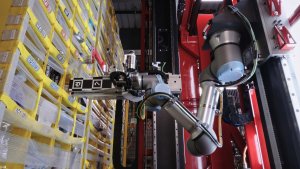Are Boardrooms Blocking Robotic Revolution?
Robotics and automation will revolutionise the way we do business - so what's holding us back?

Over the last few years, the demand for robotics has increased drastically, with business leaders across the world eager to experience the benefits automation can bring.
Now, with expectations for the market to grow even further by 2022, organisations need to understand exactly how to capitalise on opportunities of improved quality, cost reduction and first-time accuracy.
However, despite Europe being the second leading region for industrial robotics, placing itself above America, recent research shows that just 19 per cent of UK businesses actually rank the technology as a ‘top priority’. Compare this to more than 30 per cent of organisations in the U.S., and it seems we’re falling behind.
Innovation by name, but not by nature
In the UK, we’ve long been known for pioneering new inventions and being at the forefront of emerging technology trends.
And yet, despite an overall increase in businesses who are making robotics ‘more of a priority’ this year, research has shown that only 64 per cent of organisations in the UK see Robotic Process Automation (RPA) as important to their wider IT strategy.
This is compared to over three quarters of U.S. businesses who view this technology as a necessary part of their wider business plan.
Businesses in the U.S. have a clear understanding of the ways in which robotics and automation can bring important changes to the way businesses operate - increasing efficiency across the board.
If implemented correctly, RPA can have a huge amount of potential in every industry. For example, in financial services robotics can carry out tasks such as credit card application processing - exactly as a person would but through automated processes in place of human logic.
The solution - getting buy-in from the board
Dedication to running successful digital business models has improved in recent years, with a survey from PwC finding that 68 per cent of executives believe their CEO’s to be champions for digital. Compare this to the 33 per cent who were surveyed ten years ago, and organisations have come a long way.
Today those in senior positions must take the lead in the robotic revolution and introduce a culture that not only understands automated technology, but openly accepts it as necessary to carry out business functions.
Without buy-in from those in senior positions, automation will fail to be a success. In fact, buy-in from across the business is needed for full engagement in this time of digital change; every employee needs to understand how robotics can help them in their role and the wider benefits they bring.
Enabling employees, not taking them away
With recent news reporting that a third of jobs are to be automated by 2030, a common concern for the human workforce is that robots are coming to steal their jobs. However, robots shouldn’t pose a threat to the jobs that people are already doing, but should be seen as an enabler, there to assist them with these tasks.
With effective leadership, attitudes towards automation can be shifted. Rather than seeing automation as a threat, the workforce can embrace the technology that can add to, and ultimately improve, their working life.
This increased level of automation demands a change in the way business leaders view different job roles. Automation is impacting the way we work and instead of simply swapping humans for robots, the C-suite needs to put in place a strategy that allows them to stay profitable.
As back-office, mundane tasks become automated; people can be focused on the high-level strategic activities that require empathy and communication - bringing real value to the business and helping achieve business targets.
There’s still a lot to be done to educate those at management level as to the benefits of software robotics. However, if business leaders can help their employees truly get to grips with how this technology will support them, employees and organisations alike will be able to flourish in the world of digital.
An automated digital transformation
Undoubtedly, robotics will have a key role to play if businesses are going to be successful in their digital transformation journey.
Research has revealed that over two thirds of organisations have a Robotics Process Automation strategy in place, with 82 per cent using RPA to automate business processes. If implemented correctly robotics can drive business growth and help businesses achieve their goals.
For businesses looking to scale up, investing in robotics can be a big step in the right direction. Automated systems embody standardisation and control which brings flexibility to the tasks they can carry out.
Rather than just mimicking the actions of humans in activities, smart software robots can be programmed to handle each step of a wider process. The robots can then acclimatise quickly to the situation in hand, and carry out each step of the end-to-end processes.
The nirvana of ‘digital transformation’ is not simply achieved by adding a smart consumer interface, or app. Today’s businesses operate in an uncertain global economy, beset by fluctuating FX rates and changing international supply chains.
Back office processes are no longer behind the scenes – they are very much front and centre of operations. The impact of siloed, fragmented or inefficient processes therefore has a major impact on businesses ability to innovate, service customers and stay competitive.
Thanks for signing up to Minutehack alerts.
Brilliant editorials heading your way soon.
Okay, Thanks!


